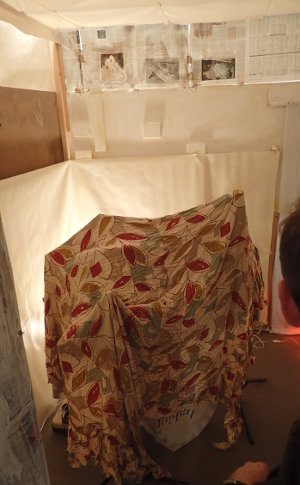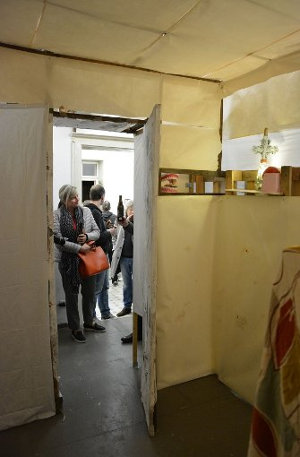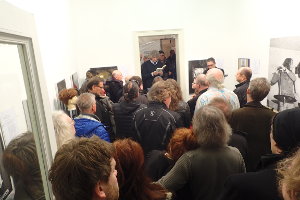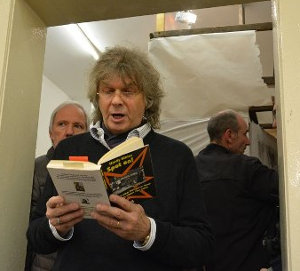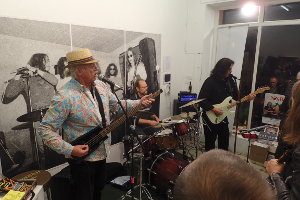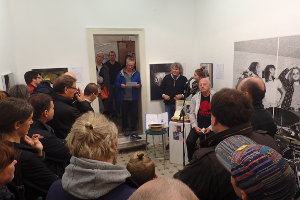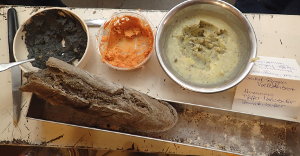Ansichten
zum Beitrag ehemaliger Luftschutzbunker zur lokalen Musik-Szene in Stuttgart
Forschungsgruppe Untertage e.V.
(
english)
Die Ausstellung kombiniert Bilder Stuttgarter Musiker und Bands in „ihrem“
Bunker mit einer jeweiligen kurzen Bunker-Vita und einer kurzen Band-Info.
Diesen Bildern werden z.T. weitere architektonische Eindrücke des jeweiligen
Bunkers zur Seite gestellt. Von jeder Band wird auf einem mp3-Player
ein Stück zur Verfügung gestellt, das einen akustischen Eindruck vom
Schaffen im Bunker vermittelt.
In der Zusammenführung der Disziplinen Fotokunst – Fotodokumentation
/ Architekturfotografie –Bandfotografie mit den Themen Lokalgeschichte
– lokale Musikgeschichte - lokale Musikszene entsteht ein spezifischer
Einblick in den Anteil der ehemaligen Luftschutzbauwerke an rund 45
Jahre musikalischer Aktivität in Stuttgart, der sich stilistisch nicht
festlegen lässt.
Rahmenprogramm:
Zur Ausstellung sind Live-Musik und Lesungen in der Oberwelt geplant,
die hauptsächlich aus den Reihen der beteiligten Musiker heraus entstehen
werden.
Hardy Sikler wird aus seinem Buch „Spot On“ lesen, das die Geschichte
der 70er-Jahre Band „Spratzel Strull“ beschreibt. Die Band wurde in
ihrem Proberaum im Bunker Badstraße von dem Kunststudenten Jonnie Doebele
fotografiert, der Motive für seine lebensgroßen Portraits suchte. Die
Ausstellung wird eines dieser Bilder zeigen.
Die musikalischen Beispiele stammen aus 10 verschiedenen Bunkern im
Stadtgebiet, die zum Teil noch heute als Proberäume genutzt werden und
reichen von Blues-Jazz-Fusion-Rock über Pop, NDW und Punk bis hin zu
Metal und Death Metal.
Hintergrund:
Ab 1939 wurden in Stuttgart öffentliche Luftschutzbunker gebaut. In
Militärkreisen und der Bauwirtschaft waren Konzepte für unterirdische
(Tiefbunker) und oberirdische (Hochbunker) Bauten schon seit Anfang
der 1930er Jahre diskutiert worden. Von den 20 während des 2. Weltkriegs
in Stuttgart gebauten Hochbunkern stehen noch 16, von den 13 Tiefbunkern
existieren noch 10. Sie erfuhren häufig diverse Nachkriegsnutzungen
und haben eine entsprechend bewegte Geschichte.
Spätestens ab Anfang der 1970er Jahre begann die Stadt Stuttgart Räume
in den Bunkern an Musiker zu vermieten, die dort Proberäume einrichteten.
Pioniere waren Bands wie „Müll“ oder „Spratzel Strull“. Manche dieser
Bands traten bundesweit oder sogar international auf. Bis heute beherbergen
mehrere Bunker im Stadtgebiet Übungsräume und damit die Basen, von denen
aus lokale Bands sich die Bühnen der Stadt, der Region und darüber hinaus
erschließen. Für sie sind Bunker keine toten Kriegsrelikte, sondern
essentieller Bestandteil einer lebendigen Musikszene der Stadt.
Der größte und prominenteste Musikbunker Stuttgarts war „die Röhre“,
deren Räumlichkeiten während des 2. Weltkriegs als Teil des „Großluftschutzraums
Wagenburgtunnel“ geschaffen wurden. Hier traten 26 Jahre lang zahllose
internationale, nationale aber auch lokale Acts auf, die in Stuttgart
unvergessen sind.
Eröffnung Freitag, 28. Oktober 2016, 19.00 Uhr
mit kurzer Einführung zur Ausstellung durch Oberwelt e.V. und Forschungsgruppe
Untertage e.V.,
Anmerkungen von Jonnie Doebele zu seinen lebensgroßen Fotoleinwänden:
Hardy Sikler liest aus „Spot On“, der Geschichte von Spratzel Strull;
Sid Steiner liest den Text biznis Bunker
Ex- Müll spielen MÜLL-Stücke und Anderes in der Besetzung
Eckardt Dietel (Müll, The Time, Villa Rouge, Insert Coin, Tun up, Spin):
Gitarre, Gesang
Klaus-Peter Grassnick (Müll, The Time, Circus O. Stark, Mocking Bird):
Bass
Peter Schmid (Anyones Doughter, Fishermans Walkband, Country Joe Mac
Donald, Ala Heiler, etc.): Percussion
Forschungsgruppe
Untertage e.V.
Besichtigung der Ausstellung bis 19. November
Mo. 21.30 bis 24.00 Uhr
Sonntag 5. 11. und 13. 11. jeweils 12 bis 16:00 Uhr u.n.V. unter Tel.0711-650067
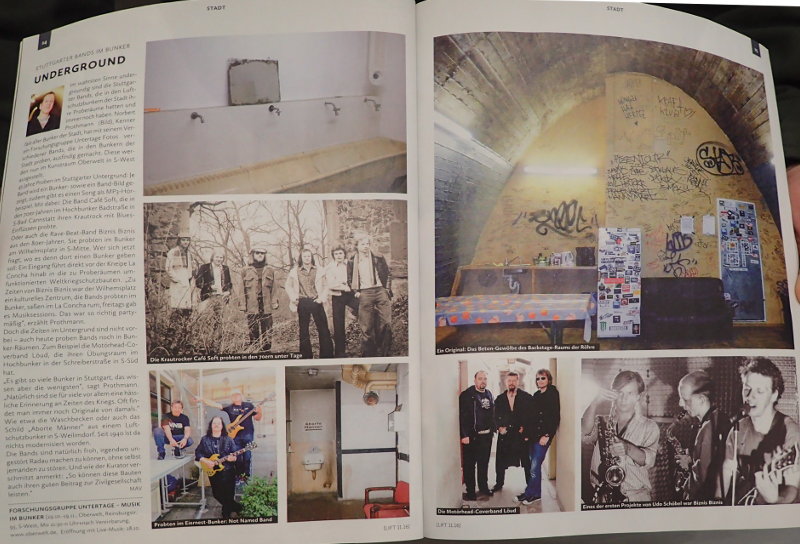
Lift
Stuttgart November 2016

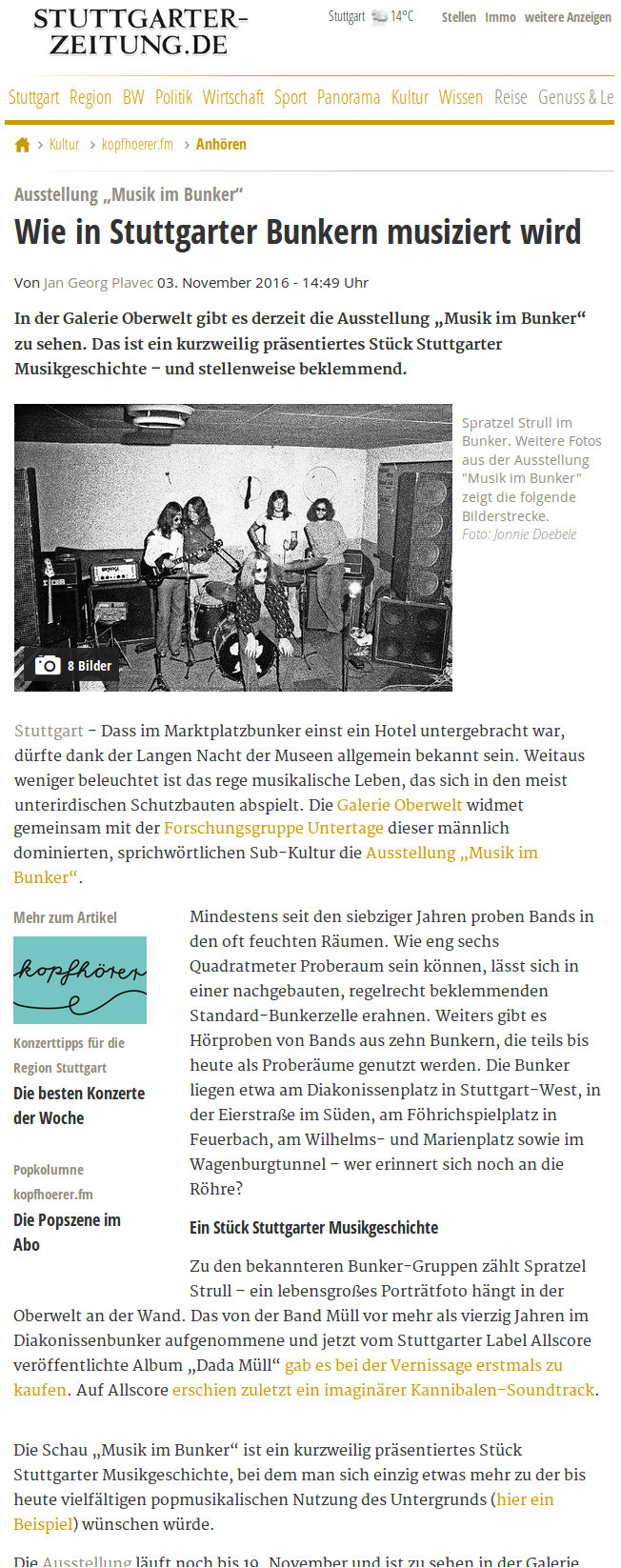
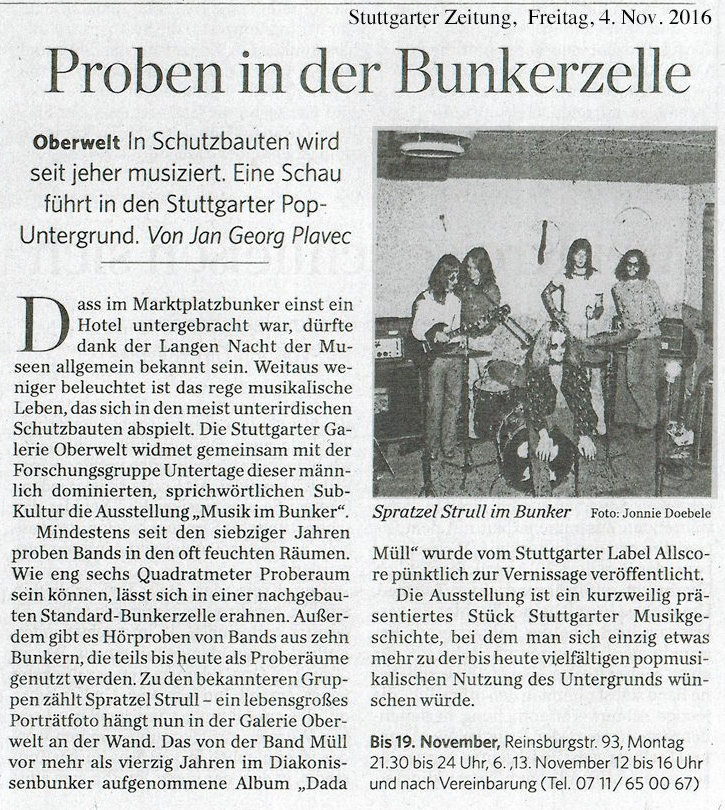
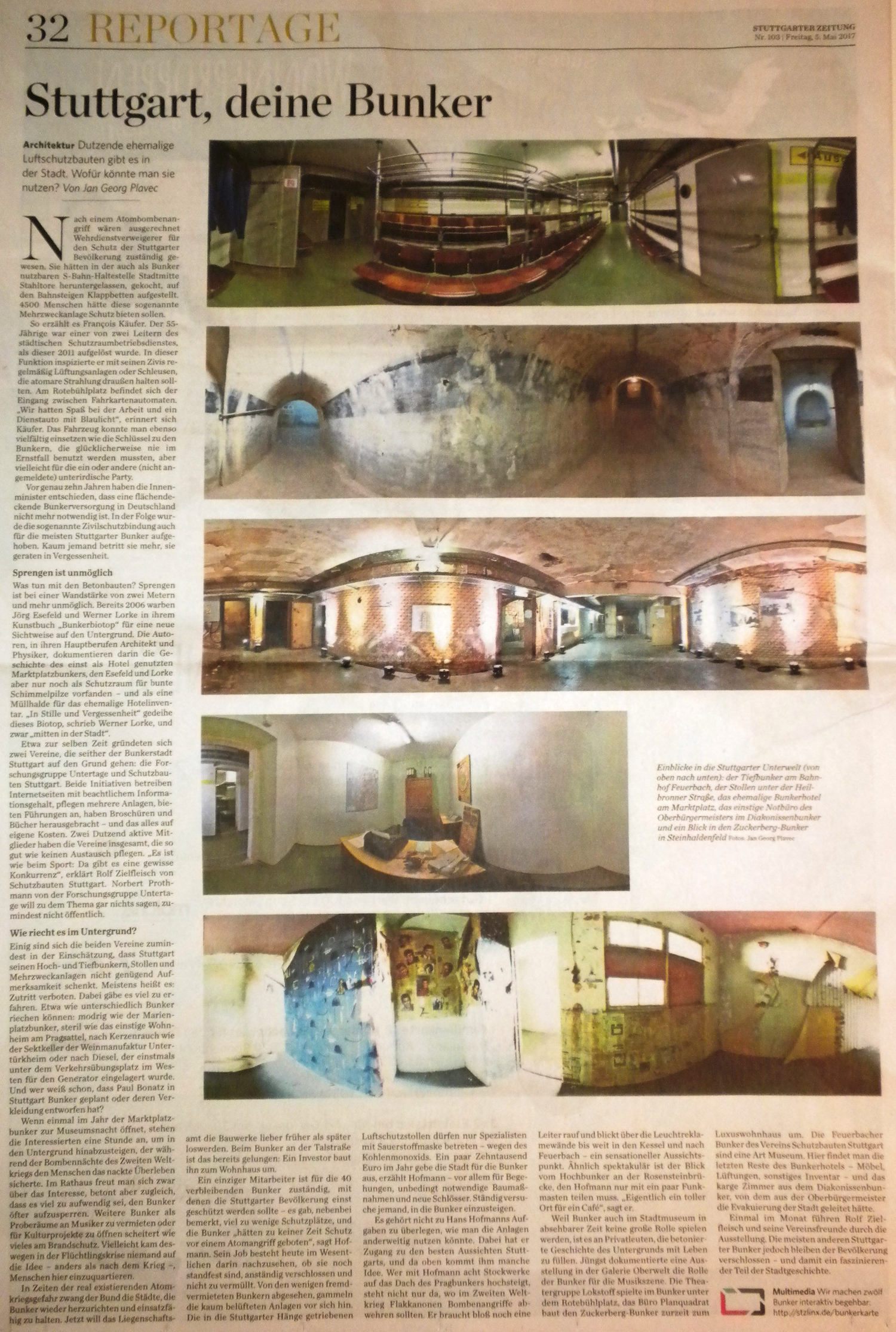
dieser Artikell auf StZ
online
Bunker
Music
Views of the contribution of former air raid shelters to the local
music scene in Stuttgart
Forschungsgruppe Untertage e.V. (Underground Research Group Association)
This exhibition combines pictures of Stuttgart musicians and bands
in “their” bunker accompanied by a brief vita of each bunker and information
on the band. The pictures will, as far as possible, be exhibited alongside
further architectural impressions of the corresponding bunker. An
mp3 player with one song from each band will provide an acoustic impression
of the work created in the city’s bunkers.
The fusion of the disciplines photographic art, photographic documentation
/ architectural photography and band photography together with the
themes local (music) history and the local music scene provides a
particular insight into the influence of former air raid shelters
on about 45 years of very diverse musical activity in Stuttgart for
which no one style can be determined.
Accompanying Programme:
Live music events and readings are planned to accompany the exhibition
at Oberwelt – mainly drawn from the ranks of the musicians represented
in the exhibition.
Hardy Sikler, for example, will read from his book “Spot On” which
tells the story of the 70s band “Spratzel Strull”. The band was photographed
during rehearsals in the “Badstraße Bunker” by then art student Jonnie
Doebele who was on the lookout for motifs for his life-size portraits.
The selected musicians originate from ten different bunkers in the
city, some of which are still used as rehearsal rooms today, and the
musical styles range from blues-jazz-fusion-rock through pop, Neue
Deutsche Welle (New German Wave) and punk to metal and death metal.
Background:
The building of civilian air raid shelters in Stuttgart began in 1939.
Concepts for underground (deep bunker) and above-ground (surface bunker)
structures were discussed in military circles and the building sector
from as early as the early 1930s. Of the 20 surface bunkers built
in Stuttgart during the Second World War 16 are still standing; of
the 13 deep bunkers 10 still exist. Following the war, they were often
used in very different ways and accordingly have colourful histories.
Sometime around the early 1970s, the City of Stuttgart began to rent
out rooms in the bunkers to musicians looking to set up rehearsal
rooms there. Bands such as “Müll” and “Spratzel Strull” were pioneers.
Some of the bands performed throughout Germany and even internationally.
To this day, a number of bunkers in the city are still host to rehearsal
rooms and therefore form a base from which local bands can perform
on stages in the city, the region and beyond. For these bands the
bunkers are not merely dead war relicts, but an essential part of
a vibrant music scene in the city.
The largest and most prominent music bunker in Stuttgart was “die
Röhre” (the pipe), which was built during the Second World War as
part of the “Large Wagenburg Tunnel Air Raid Shelter”. For more than
26 years, numerous international, national and local acts that will
remain unforgotten in Stuttgart performed here.
Forschungsgruppe
Untertage e.V.
Opening: Friday
28th October 2016, 7pm
The exhibition can be viewed until the
19th November
Opening hours: Mondays 9 pm till midnight and by appointment
(ph: 0711-650067)
 Lift
Stuttgart November 2016
Lift
Stuttgart November 2016


 dieser Artikell auf StZ online
dieser Artikell auf StZ online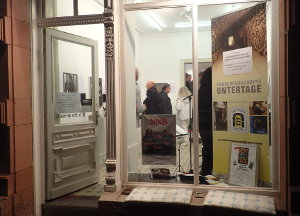
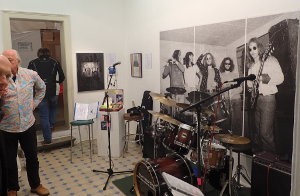
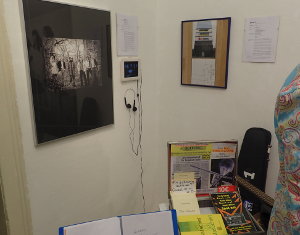
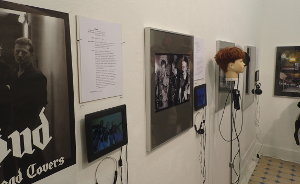
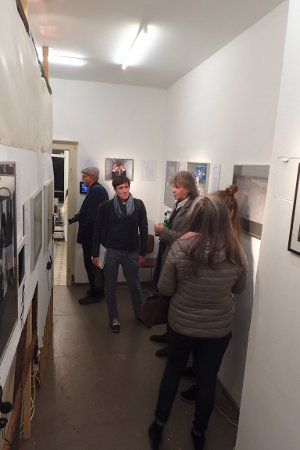
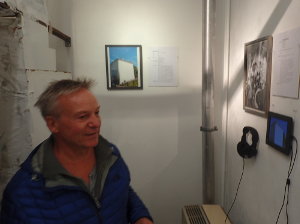
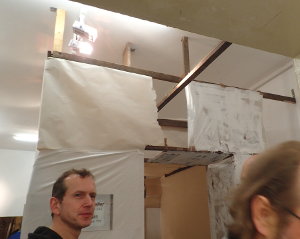 1:1-Modell
eines Bunker-Übungsraumes 2,04m auf 2,90m, Ausführung: P. Prothmann/Peter
Haury
1:1-Modell
eines Bunker-Übungsraumes 2,04m auf 2,90m, Ausführung: P. Prothmann/Peter
Haury 